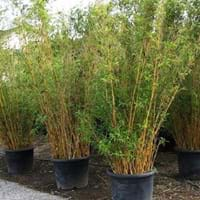Life Span
Perennial
Perennial
Origin
Europe, Asia
China
Types
Not Available
Greenstripe Vivax, Moso, Weavers Bamboo, Oldhamii
Habitat
Dry areas, Roadsides, stream banks, Stream side, Waste areas
Subtropical climates, Wet Woods
USDA Hardiness Zone
3-7
8-12
Sunset Zone
1a, 1b, 2a, 2b, 3a, 3b, 4, 5, 6, 7, 8, 9, 10, 11, 12, 13, 14, 15, 16, 17, 18, 19, 20, 21, 22, 23, 24
H1, H2, 8, 9, 14, 15, 16, 17, 18, 19, 20, 21, 22, 23, 24
Habit
Clump-Forming
Clump-Forming
Minimum Width
Not Available
Flower Color
White, Lavender
Pale White
Flower Color Modifier
Bicolor
Bicolor
Fruit Color
Sandy Brown
Not Available
Leaf Color in Spring
Gray Green, Gray
Green
Leaf Color in Summer
Gray Green, Gray
Light Green
Leaf Color in Fall
Gray Green, Gray
Green
Leaf Color in Winter
Light Green
Green
Leaf Shape
Arrowhead
Acicular
Plant Season
Spring, Summer, Fall
Spring, Summer, Fall, Winter
Sunlight
Full Sun, Partial Sun
Full Sun, Partial Sun
Growth Rate
Fast
Very Fast
Type of Soil
Clay, Loam, Sand
Loam, Sand
The pH of Soil
Acidic, Neutral, Alkaline
Acidic, Neutral, Alkaline
Soil Drainage
Well drained
Well drained
Bloom Time
Summer, Late Summer, Early Fall
Not Available
Tolerances
Drought, Dry soil
Drought
Where to Plant?
Container, Ground
Container, Ground
How to Plant?
Seedlings
Grafting, Seedlings, Stem Planting, Transplanting
Plant Maintenance
Low
Medium
Watering Requirements
Do Not over Water, Never Over-water, Requires regular watering, Water when soil is dry
Needs watering once a week, Use Mulches to help prevent water loss during hot and windy weather, Water Deeply
In Summer
Lots of watering
Lots of watering
In Spring
Moderate
Moderate
In Winter
Average Water
Average Water
Soil pH
Acidic, Neutral, Alkaline
Acidic, Neutral, Alkaline
Soil Type
Clay, Loam, Sand
Loam, Sand
Soil Drainage Capacity
Well drained
Well drained
Sun Exposure
Full Sun, Partial Sun
Full Sun, Partial Sun, Partial shade
Pruning
Prune if you want to improve plant shape, Prune in spring, Remove damaged leaves, Remove dead leaves
Do not prune during shooting season, Prune in late summer or fall, Remove damaged leaves
Fertilizers
fertilize every 2-3 weeks while growing, fertilize in growing season
All-Purpose Liquid Fertilizer
Pests and Diseases
Caterpillars, Leaf Hoppers, Nematodes, Spider mites
Black sooty mold, Mealybugs, Mosaic viruses, Powdery mildew, pythogens, Stem rot
Plant Tolerance
Drought, Frost
Drought
Flower Petal Number
Single
Single
Fragrant Bark/Stem
Yes
No
Foliage Texture
Medium
Coarse
Foliage Sheen
Matte
Matte
Attracts
Flying insects, Insects, Spider Mites
Beetles, Bugs, Mites
Allergy
Avoid during Pregnancy, Headache, Stomach pain, Vomiting
allergic conjunctivitis, Asthma, Rash, Respiratory distress
Aesthetic Uses
Beautification, Landscape Designing, Showy Purposes
Showy Purposes
Beauty Benefits
Not Available
Not Available
Environmental Uses
Air purification
Agroforestry, Air purification, No fertilizer, pesticides, or herbicides needed
Medicinal Uses
Arthritis, Cold, constipation, Fever, Insomia, Migraines, Upset stomach
Aging, Anti-fungal, Antispasmodic, Digestive disorders, Obesity
Part of Plant Used
Whole plant
Stem, Tree trunks
Other Uses
Air freshner, Decoration Purposes, Employed in herbal medicine, Making Perfumes, Making Shampoo, Making Sweet Scented Oil, Medicinal oil, Used as Ornamental plant, Used for its medicinal properties
Economic Purpose, Traditional medicine, Used As Food, Used for woodware, Used in Furniture, Used in paper industry
Used As Indoor Plant
Yes
No
Used As Outdoor Plant
Yes
Yes
Garden Design
Container, Herb / Vegetable, Mixed Border
Feature Plant, Screening / Wind Break, Tropical
Botanical Name
NEPETA cataria
BAMBUSA beecheyana
Common Name
Cat Nip, Catnip
Beechey's Bamboo, Clumping Bamboo
In German
Katzenminze
Verklumpung Bambus
In French
cataire
clumping Bamboo
In Spanish
Catnip
clumping Bamboo
In Greek
Είδος δυόσμου
συσσώρευση μπαμπού
In Portuguese
catnip
bambu aglutinação
In Polish
Kocimiętka
zbicie bambus
In Latin
catnip
clumping Bamboo
Phylum
Magnoliophyta
Magnoliophyta
Class
Magnoliopsida
Liliopsida
Clade
Angiosperms, Asterids, Eudicots
Angiosperms, Commelinids, Monocots
Subfamily
Nepetoideae
Bambusoideae
Number of Species
Not Available
Season and Care of Catnip and Clumping Bamboo
Season and care of Catnip and Clumping Bamboo is important to know. While considering everything about Catnip and Clumping Bamboo Care, growing season is an essential factor. Catnip season is Spring, Summer and Fall and Clumping Bamboo season is Spring, Summer and Fall. The type of soil for Catnip is Clay, Loam, Sand and for Clumping Bamboo is Loam, Sand while the PH of soil for Catnip is Acidic, Neutral, Alkaline and for Clumping Bamboo is Acidic, Neutral, Alkaline.
Catnip and Clumping Bamboo Physical Information
Catnip and Clumping Bamboo physical information is very important for comparison. Catnip height is 980.00 cm and width 60.00 cm whereas Clumping Bamboo height is 1,070.00 cm and width Not Available. The color specification of Catnip and Clumping Bamboo are as follows:
Catnip flower color: White and Lavender
Catnip leaf color: Gray Green and Gray
Clumping Bamboo flower color: Pale White
- Clumping Bamboo leaf color: Green
Care of Catnip and Clumping Bamboo
Care of Catnip and Clumping Bamboo include pruning, fertilizers, watering etc. Catnip pruning is done Prune if you want to improve plant shape, Prune in spring, Remove damaged leaves and Remove dead leaves and Clumping Bamboo pruning is done Do not prune during shooting season, Prune in late summer or fall and Remove damaged leaves. In summer Catnip needs Lots of watering and in winter, it needs Average Water. Whereas, in summer Clumping Bamboo needs Lots of watering and in winter, it needs Average Water.





